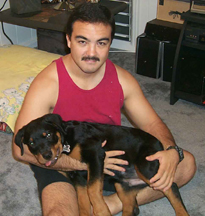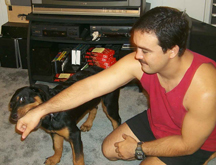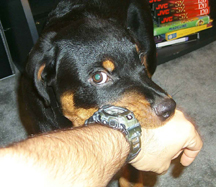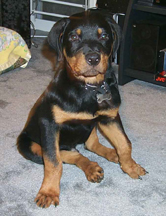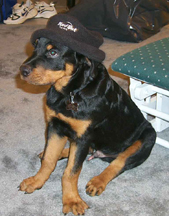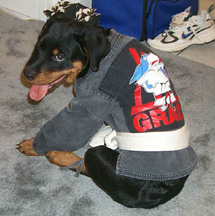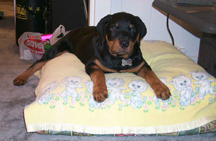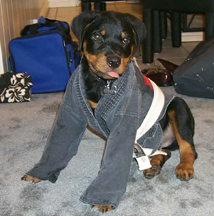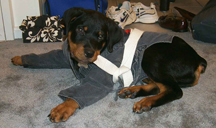"The
Rock" Onzuka
Here is a little
pictoral of our family's pride and joy and (pain in the a**).
His name is The Rock because he IS the most electrifying dog
in sports entertainment.
These pictures were taken on July 11, 2001. He is about 15
1/2 weeks old and is about 34lbs. As you can see, I am in the
process training him to bite candy asses and jabronies. The gi
in the bottom pictures was Brandi's, but not anymore. The Rock
is also the newest member of the Relson Gracie Team. I apologize
for the picture with the Hard Rock Cafe hat, that was totally
the wife's idea. As you can see in the picture, The Rock is not
very happy with it either.
More puppy pictures
and some background on Rotteilers
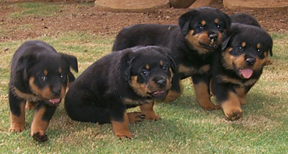
Rottweilers are excellent
companions and great guard dogs! If you are looking for a large
dog, but are a little detered from getting a Rott because of
all the stories you have heard, let me tell you about Rottweilers.
Generally, a dog is a product of his environment just like a
child. If an owner beats or mistreats a child, the child will
grow up with behavioral problems, why would you expect different
from a dog?
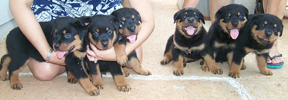 
Just look at these
pictures. Do they look like dangerous dogs to you? I apologize
in advance for the slow loading of this page, but I just had
to include all these pictures.
There are
four males and two females in this litter:
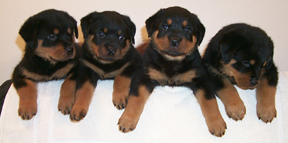 |
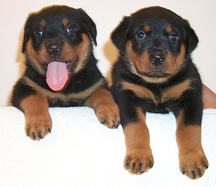 |
Four
males
(The Rock is on the far right, always the rebelious one) |
Two females |
The
Rock's Litter Statistics:
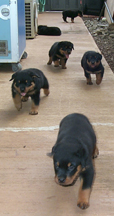 |
Breed: German Rottweilers
Total litter size: 6 puppies
Number of males: 3
Number of females: 2
Date of birth: March 25, 2001
Place of birth: Kapolei, Oahu, Hawaii
AKC certified: Yes, both parents were AKC certified and all puppies
come with AKC papers |
Parents:
A picture of the
parents are below. Both parents are certified by the American
Kennel Club (AKC) as German Rottweilers. The German line are
said to be generally larger than the American line of Rottweillers,
although some say the opposite. Both dogs have an extremely good
temperments and have NEVER shown any aggressive tendencies. The
parents are from two different breeds in order to produce a strong
litter. This is the first and only litter from these two dogs
and it is generally said that smaller litters produce healthier
puppies. Sam (father of the litter) is thin because he is only
1 1/2 years old and was experiencing a growth spurt and cannot
eat enough to keep up.
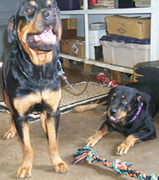 |
Father:
Name: Sam
Mother:
Name: Xena
|
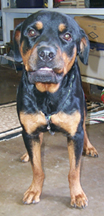 |
|
Sam*
& Xena |
|
Sam* |
*Keep in mind
that at the time of this picture Sam was only about 1 1/2 years
old, so he has about 1 1/2 more years to fill out.
Pictures
just one month earlier:
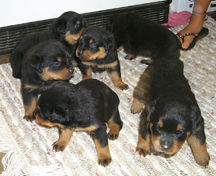 |
These pictures
were taken on April 15th, 2001. The puppies were already very
active and exploring the area. |
|
This was probably
the last time we were able to line them up like this without
holding everyone of them. |
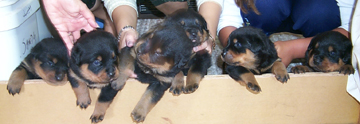 |
Do you want to learn
more about Rottweilers?
Here are some
tidbits from The
American Rottweiler Club Website.
History
of the Rottweiler:
The Rottweiler
is said to be descended from the drover dogs of ancient Rome.
These mastiff-type dogs accompanied the Roman Legions across
the Alps herding their cattle and guarding their camps. One such
camp, on the banks of the Neckar River in what is now southern
Germany, was the origin of the town of Rottweil (named for the
red tile roofs of the villas built by the Romans). Through the
mid-1800's, the cattle trade flourished in Rottweil, as did the
Rottweiler Metzgerhund (butcher dog), who drove the cattle to
market and returned with the filled purses of their masters around
their necks. As rail transportation became the primary means
of bringing cattle to market, the dogs were used less frequently.
Legend has it that by 1905 there was but one Rottweiler left
in the town of Rottweil. By the early 1900's though, the Rottweiler
gained popularity as a police dog. Several Clubs were formed,
and in 1921 united as the Allgemeiner Deutscher Rottweiler Klub
(ADRK). In 1931, the first Rottweiler was admitted to the AKC
Stud Book. Through the 1970's, the Rottweiler was a fairly uncommon
dog in the United States, ranking in the middle of AKC registered
breeds in terms of number of dogs registered. In the early 1980's
the Rottweiler began a meteoric rise in popularity, and has been
the second most popular AKC breed since 1992.
Characteristics
and Temperament:
The Rottweiler
is a medium-large, powerful dog. His compact and substantial
build denotes great strength, agility and endurance. On average,
males will range from 95 to 135 lbs and 24" to 27"
at the shoulder. They are more massive throughout with larger
frame and heavier bone than bitches. Bitches will range from
80 to 100 lbs and from 22" to 25" at the shoulder.
Animals can be found which are taller or shorter than these measurements,
however, they are not considered typical by the breed standard.
The Rottweiler is ALWAYS black, with clearly defined markings
on cheeks, muzzle, chest and legs as well as over both eyes,
that range from tan to deep mahogany. His coat is straight, coarse
and of medium length, with an undercoat varying in degree based
on climatic conditions. The Rottweiler is a calm and self-confident
dog, who has an inherent desire to protect home and family. Personality
may range from highly affectionate to extremely aloof. He is
not shy nor highly excitable. He is an intelligent and highly
trainable dog. He is also very much a companion, often following
their family members from room to room in the home. Because of
his size and strength, it is imperative that he receive proper
socialization and obedience training from an early age. Nervous,
shy, excitable or hyperactive individuals are exhibiting traits
which are undesirable in an animal the size and strength of the
Rottweiler and should be avoided.
Miscellaneous
Information:
I have been receiving a lot of emails concerning Rottweilers.
I thank them for the emails, but by no means am I a "Rottweiler
expert." I just passed on info that I learned from books
or from other Rottie owners. Here are some of the information
that I have gathered or experienced first hand. Please feel free
to email me with additional information that I missed or items
that you do not agree with.
First off, there
are some things that are inherent in Rottweilers:
- They are naturally loyal dogs and very protective of their
family. This does not have to be taught.
- They generally choose one person to be the master or alpha.
They will want to stay close and follow that person around and
keep them in view at all times.
- They are family dogs and like to be around the family, not
in isolation.
- They are smart dogs so you can keep them entertained by teaching
them tricks or putting them to work (fetching the paper or pulling
a wagon). If they are bored, they will find their own entertainment.
- Bigger is not necessarily better, the bigger the dog is, the
more prone to hip dysplasia (mine needed surgery after a year)
and larger dogs live shorter lives. Also they will need more
exercise to keep that extra weight muscle instead of fat that
puts strain on the dog.
Picking out a puppy:
1) Hold them in your hands like a baby facing you and see if
the dog looks you in the eye or turns away (if he looks at you
in the face, he may have trouble with authority)
2) Drop your keys or a bowl to make a loud noise and see which
puppy approaches to investigate the bowl (this shows courage
and that he will not run in the face of danger)
3) Squat down and call to the puppies to see which one comes
to you (again weeds out the timid pups)
4) The biggest pup will not necessarily grow into the biggest
(my dog was the largest of the litter, but his brother is 30lbs
heavier and larger)
5) A dog is like a child and is a product of their environment.
If you give them a lot of love and treat them nice, they will
be part of the family and inherently protect the family. For
the current owners, just watch to see how the puppies and adult
dogs are treated. Are they well behaved or cower when the master
comes by? This could mean that they get hit as punishment.
There are certain
ways to make sure that a Rottie knows their place in the heirarchy
of the family too.
1) You slowly introduce children to the dog or if he is a puppy
you let your kids play with him (supervised of course so the
kids don't do anything mean to him). Let your dog lick your
kids and basically show his love to your family.
2) Some people say that if he is an indoor dog or an outside
dog that can see your family eat, you always feed him after your
family has finished (dogs are pack animals and the alpha's eat
first, the subordinate dogs eat last). I have never done this.
3) Training, training and more training. This is the most important!
Take your dog to multiple obedient courses to make sure that
you and everyone in your family can command your dog. I have
my daughter practice training with him so he knows that she is
higher on the food chain then he is. After he gets larger, usually
the man of the house will have to train him so that the corrections
are given with enough force to deter disobience. My wife and
daughter can't pull the training collar (ie choker chain) hard
enough to make him listen sometimes. Always remember the order
(Call the dog by name, give verbal command, then give a correction
if the dog did not respond. If you give a stay command, do not
give it more than twice, instead pull the dog to the same spot
so that they learn, that they have to listen to the first command
and won't be able to do anything else until that command is followed).
4) Training is an ongoing task. Every so often you have to go
over the commands so that your dog is familiar with them and
stays obidient.
Please feel
free to email me with any comments, suggestions, or info on Rotties.

Last updated 1/2/04. |



